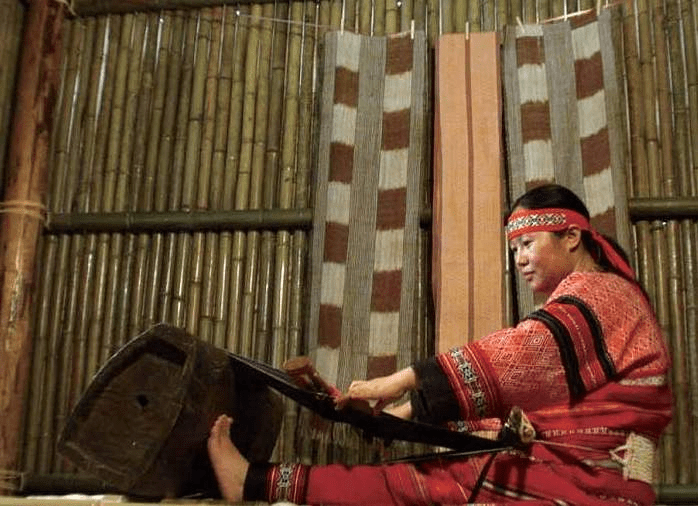尤瑪傳奇
尤瑪·達陸是台灣原住民泰雅族的傳奇人物。
The Story of Yuma
Yuma Taru is a legendary figure among the indigenous Atayal people of Taiwan.
泰雅族是台灣十六個原住民中,分布最廣的一族,其分布區域橫跨宜蘭縣、新北市、桃園市、新竹縣、苗栗縣、臺中市與南投縣,佔臺灣中北部三分之一的山區。
The Atayal people are one of 16 officially recognized indigenous tribes of Taiwan. Among indigenous tribes, they control the largest territory. The Atayal homeland is in the northern one-third of Taiwan’s mountainous regions, including parts of Yilan, Taipei, Taoyuan, Hsinchu, Miaoli, Taichung and Nantou.
2016年,52歲的尤瑪獲得政府頒發 「重要傳統藝術保存者」的榮譽,表彰她二十多年來致力於保存、重製、發揚泰雅族傳統織物的貢獻與成就。
In 2016, the 52-year-old Yuma was designated an important conserver of traditional art by the Taiwanese Ministry of Culture. The honour highlights the over two decades she dedicated to preserving, recreating and promoting traditional Atayal textile and fabric arts.

流淚播種
尤瑪出生於1963年苗栗縣的泰安鄉,父親是原籍湖南的軍人,在1949年隨著蔣介石政權從中國撤退到台灣來。後來,娶了一位泰雅族的姑娘—尤瑪的母親。
Sowing the Seeds
Yuma was born in 1963 in Tai’an Township, Miaoli County, Taiwan. Her father was a soldier, originally from China’s Hunan Province, who escaped in 1949 to Taiwan with Chiang Kai-shek’s regime when communism took hold in China. He would go on to marry an indigenous Atayal woman—Yuma’s mother.
1980至1990年代是台灣反抗獨裁政權、要求民主,提倡多元文化及本土化運動風起雲湧的時代。當時原住民自覺和爭取自身權益的聲音也沒有缺席。尤瑪也參與了原住民的復興運動。1997年她與一群泰雅族知識青年組成苗栗縣泰雅北勢群文化協進會,從事部落兒童、婦女、青少年的民族教育工作及傳統祭典的推展,而尤瑪負責研究已經凋落的泰雅族織布文化。
The period from 1980 to 1990 in Taiwan was marked by movements against authoritarianism, toward democratization and the promotion of Taiwan’s native, multicultural heritage. It was a time of increasing self-consciousness for Taiwan’s indigenous peoples and demands for more representation. Yuma was active in the indigenous revival movement. In 1997, she formed a cultural association for the Beishi Atayal sub-group in Miaoli with a group of Atayal colleagues. They provided cultural education to Atayal children and women—passing on invaluable cultural inheritances to a new generation of the Atayal people. Yuma was put in charge of researching the critically endangered Atayal tradition of weaving.
1895至1945年日本在台灣的殖民政權,強迫原住民現代化或皇民化的過程中,極力禁止原住民原來的信仰、以及紋面、獵首和織布等習俗。接續日本人統治台灣的蔣介石政權,將台灣中國化的過程中,同樣輕視原住民的文化。加上自日治時期起,外來布料的引進,使得許多原住民的中年婦女,甚至老一輩的族人,都不會織布。泰雅織品因此四散、織布技術因此凋零。
Taiwan, from 1895 to 1945, was a Japanese colony. The colonial regime imposed the kominka policy on Taiwan’s indigenous tribes in order to “modernize” Taiwan’s backward First Nations. Japan strictly banned traditional religions, facial tattoos, headhunting and weaving cultures, etc. With the arrival of Chiang Kai-shek’s Chinese Nationalist regime in 1945, the sinicization policies instituted by that government equally oppressed Taiwan’s native heritage. Additionally, economic modernization since Taiwan’s Japanese era and modern international trade meant that traditional weaving techniques became increasingly irrelevant. Over time, this unique Atayal form of cultural expression became virtually lost even to the Atayal people themselves.
尤瑪曾於1989任職於台中縣立文化中心博物組編織工藝館,是個公務員,1992擔任東勢國中國文教師,這些都是公認為較穩定的工作。但是重振泰雅文化的使命感,讓她在29歲這一年辭去了穩定的工作,開始四處奔走請教碩果僅存的泰雅耆老。尋訪國內外博物館館藏的泰雅織物,甚至於考入輔仁大學織品服裝研究所(1995-1998)專心研究織品,他的畢業論文就是有關泰雅服飾的原料、織機、染織法、族內各亞群織品特色、織布相關習俗及紋飾意義等的研究。
In 1989, Yuma was a civil servant in the Taichung County Cultural Centre, overseeing weaving arts. She became a teacher in 1992 at Dongshi Middle School. Both positions were considered stable public-sector jobs. However, at the age of 29, she resigned from her position to pursue a career in conserving Atayal weaving culture. Yuma began travelling across Taiwan, tracking down Atayal elders who may still remember the rapidly fading traditions of the Atayal people. She visited museums abroad to examine Atayal textile specimens in their collections. In 1995, Yuma began graduate studies at the College of Fashion and Textiles at Taipei’s Fu Jen Catholic University. Her thesis focused on Atayal clothing, materials, weaving equipment, dyeing technique, the unique differences between Atayal sub-groups in weaving and various other customs and traditions related to Atayal weaving.

歡呼收割
尤瑪研究有成,將傳統織品的織法以現代工藝技術(如組織圖分析),重新記錄、建檔並建構泰雅服飾文化的整體語系。她於2001至2006年藉由政府的補助方案在苗栗泰安鄉的象鼻部落逐步完成野桐工坊暨泰雅染織文化園區的建立,雇用部落婦女、教導他們捨去傳統腰機,改用高機重製傳統服飾。並承接國內外博物館委託重製傳統服飾做為館藏品,及策畫泰雅傳統服飾的展覽。她深厚的泰雅織物及文化知識,也獲得知名電影導演魏德聖的青睞,在2011年委託她為泰雅族人抗日電影《賽德克·巴萊》製作劇服。
Reaping the Harvest
Using modern recording methodologies, Yuma has recreated and documented traditional Atayal weaving techniques that were once lost. She has also reconstructed high-level overviews of Atayal weaving culture. From 2001 to 2006, Yuma successfully applied for funding from the Taiwanese government to establish the Lihang Workshop of Atayal Dyed Weaving Culture Park in her native Tai’an Township’s Xiangbi Indigenous Reserve. The workshop employs and trains indigenous women in the craft of weaving. They also replaced the labour-intensive traditional back-strap looms with modern mechanized equipment. Yuma’s workshop has been tasked by both domestic and international museums to recreate traditional textiles for exhibition and collection. Her deep knowledge of Atayal culture and weaving techniques even landed her in the movie industry. In 2011, Taiwanese director Wei Te-Sheng commissioned Yuma to recreate indigenous costumes for his critically acclaimed Taiwanese historical epic Seediq Bale.
其實尤瑪除了是傳統泰雅族染織工藝的傳承者之外,也戮力創造新傳統,自2000年起她創作許多融入泰雅意象和精神的纖維新藝術,包含公共藝術和服裝設計。她所創作的作品都是由她發想、設計,然後帶領野桐工坊的團隊一起完成的,例如:
In addition to conserving traditional Atayal culture, Yuma is also highly involved in pioneering new forms of Atayal cultural and artistic expressions. Since 2000, Yuma has led her workshop toward expanding its activities beyond conservation efforts. They have since branched into creating new Atayal art installations for public spaces and have also engaged in modern fashion design that incorporates traditional Atayal influences. Under Yuma’s leadership, the workshop’s creations include:
- In 2009 — the “Pursuit of Dreams” art installation for the Kaohsiung metro system.
- 2010–2015 — five Atayal-inspired “Heart of the Forest” fashion shows in collaboration with Shei-Pa National Park, with outdoor runways constructed in actual forest settings.
- In 2016 — the “Four seasons · Islands” art installation at TPE Int’l Airport Terminal 1.
尤瑪有深厚原住民文化的實力,而且在漢文化教育體系下養成的她也了解主流文化的品味及官僚機構運作的方式,加上她無私奉獻、目標宏大、一步一腳印、涓滴成河、終於經營有成;她自己成為文化界的巨擘,而她的工坊是少數在經濟上能自給自足的原住民工坊。但是她還有更宏大的目標,她希望有一天能成立泰雅染織工藝村、染織博物館及民族藝術學校;要達成這些目標,前路仍艱,但她不氣餒,她說29歲那年下定決心重建泰雅織布文化時,一無所有,一路走來總算稍有所成,所以她相信只要不放棄,未來的願景終會實現。
Yuma draws deeply from her indigenous cultural roots and combines them with her keen knowledge of the Taiwanese mainstream. Her skillful navigation of Taiwanese society and government has enabled her to achieve many things for herself and her indigenous Atayal community. Her efforts in promoting the weaving culture of her ancestors have seen her become a major cultural figure in the Taiwanese social landscape. The indigenous workshop she created is now economically self-sufficient—offering invaluable opportunities for a marginalized group. But she has grander ambitions. Yuma hopes to one day establish an Atayal weaving and dyeing village, an indigenous textile museum and an indigenous school of arts. The road ahead will not be easy, but Yuma is unfazed. Recalling her first steps on this journey at the age of 29, she is encouraged by the progress she has made during all those years. Yuma has faith that so long as she continues to strive and refuses to give up, her ambitions and dreams for the future will one day surely be realized.
今日台灣成為較為尊重多元文化的社會,她也是重要的推手之一,她得到的榮譽和成就說明一切。尤瑪·達陸的故事可說是台灣原住民的一則傳奇。
Taiwanese society today is one that respects its multicultural and multiethnic roots. Much of this movement toward tolerance and embrace is thanks to the efforts of individuals like Yuma. The flowering of Taiwan’s diverse cultures today is every bit a testament to the unique story of Yuma.




